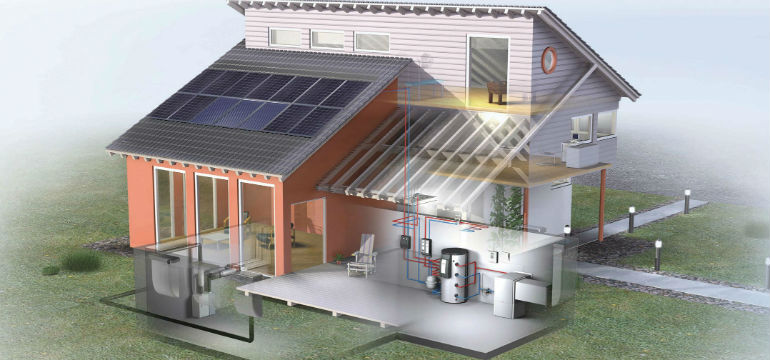
Get up to 4 quotes by filling in only 1 quick form

Slash your energy bills by installing a heat pump

We’ve helped over 500,000 homeowners reduce their carbon footprint
- GreenMatch
- Ground Source Heat Pumps
- Pros and Cons of Ground Source Heat Pumps
Pros and Cons of Ground Source Heat Pumps

Ground source heat pumps are excellent low-carbon heating systems that are able to extract warmth from the ground by using buried pipework rather than producing it by burning fossil fuels, becoming a highly efficient and cost-effective option for your home.
Given the fact that they are able to extract heat stored in the ground to heat up your home, they take advantage of the relatively consistent temperatures of the earth throughout the year, making them less susceptible to changing adverse weather conditions during the winter season
In addition, once installed, there are very few running costs, and as this type, among various heat pumps, is eligible for the Boiler Upgrade Scheme, you can actually earn a bit of additional income on the side. However, the initial price of a ground source heat pump is high, which can turn some homeowners away.
In order to help you make a final decision, in this article we have elaborated an extensive guide that covers all the advantages and disadvantages to know before purchasing your next best ground source heat pump.
- Low running costs
- Energy efficient
- Low carbon heating
- Provides cooling and heating
- Eligible for grants
- Constant and inexhaustible
- Virtually silent
- Increases property value
- High installation costs
- Efficiency affected by soil type
- Tricky to install in retrofits
Having said this, the final decision will ultimately depend on your personal circumstances, for this reason, it’s always advisable to gain insight from professionals in the field.
If you want to invest in a ground source heat pump, GreenMatch can provide you with a free quote comparison service that allows you to compare offers from different suppliers in your area. This is a non-binding service, so you can take your time to find the solution that suits you best. Just fill in the form to request offers.
- Quotes from local engineers
- Payment by finance available
- Save up to £1100 per year
It only takes 30 seconds



How Does a Ground Source Heat Pump Work?
A ground source heat pump has a quite simple functioning. In fact, it works the same way your fridge does: it transfers heat from one space to another. The main difference relies on what those spaces are. In the case of the fridge, it extracts heat from inside the fridge and places it outside.
A ground source heat pump (GSHP) transfers heat from the ground to your house. The constant year-round temperature of the ground—approx. 8-12°C—heats up the underground pipes that are able to capture this heat, heat it up further, and transport it to the wet central heating system in your house, such as radiators, underfloor heating, showers, and faucets.
The video below explains how a ground source heat pump works:

Of course, such a device requires a specialist to carry out the installation. The difficulties show up at the external part of the GSHP installation. It is necessary to excavate and to distribute an extensive net of pipes (those that will take heat to or from the ground). Fortunately, this doesn’t generate major environmental issues.
A GSHP is a versatile and eco-friendly heating and cooling system, though it also has its disadvantages. So let’s list both its pros and its cons.
What Are the Advantages of GSHPs?
The following list comprises what we consider are some of the most outstanding advantages of GSHP:
- Low running costs – Their running costs of heat pumps are very low compared to those of direct electric heating systems. That is due to the fact that the only basic element of a simple GSHP that requires the use of electric energy is the compressor.
- Energy-efficient – In fact, the energy output is roughly 3-4 times greater than the energy that is required to run them.
- Low carbon heating system – They don’t produce carbon emissions on site and don’t involve the use of any fuels, and are therefore a good choice if you’re looking for low carbon heating solutions. Additionally, if a sustainable source of electricity is used to power them, such as solar panels, they don’t produce carbon emissions at all.
- Provides both cooling and heating – Unlike air conditioners, which demand the use of a furnace for heating. That is achieved by means of a reversing valve that changes the direction of circulation of the fluid.
- Eligible for grants – The UK Government offers ground source heat pump grants, such as the Boiler Upgrade Scheme. By making use of grants, you can lower installation and/or running costs, making it an even more attractive investment.
- Constant and inexhaustible – Ground heat is usually constant and inexhaustible (there are almost no fluctuations in its capability for heating and cooling), is available worldwide and has a massive potential (estimated at 2 terawatts).
- Virtually silent – GSHPs are silent runners, so you or your neighbours will not be bothered by a noisy heat pump unit.
- Increases property value – If the GSHP installation is well designed, it will increase the value of your property, making it a great home improvement option for your home.

What Are the Disadvantages of GSHPs?
The list below shows the probably most concerning disadvantages related to GSHP
- High installation costs – The installation costs of a GSHP are considerably higher than the costs of installing a traditional furnace and air conditioner. That requires a quite expensive initial investment. However, there are grants available to you that can help lower the installation costs.
- Efficiency affected by soil type – Though GSHPs can be installed in either sandy or clay soil, sandy soil will reduce the efficiency slightly. That being said, your installer will be able to assess this and implement the necessary components to maximise efficiency for your specific property.
- Tricky to install in retrofits – GSHPs are most common for new-builds, as it can be a bit tricky to install in existing builds. If a property does not have a large enough garden, then a vertical ground source heat pump borehole can be installed instead, though this is more costly than a horizontal system.
Is Ground Source Heat Pump Right For Your Home?
A ground source heat pump is typically great for new builds rather than retrofits. This is due to the extensive underground piping work that needs to be done in order to install the system, whether you choose a vertical borehole or a horizontal trench. It is best to have an installer come and inspect your property and help you determine the most suitable ground source heat pump for your home.

Ready to take the next step and install a ground source heat pump at home? Fill in our contact form to receive up to 3 offers from installers in your area. Our quote comparison service is completely free of charge and non-binding, so you can take your time to compare the best offers!
- Quotes from local engineers
- Payment by finance available
- Save up to £1100 per year
It only takes 30 seconds




Valli has been writing well researched articles about renewable energy, sustainability and green technologies for GreenMatch since 2017. Her work has been published in various media such as Entrepreneur, Business Insider, Canadian Geographic, uSwitch, and eCycle.
 We strive to connect our customers with the right product and supplier. Would you like to be part of GreenMatch?
We strive to connect our customers with the right product and supplier. Would you like to be part of GreenMatch? 


